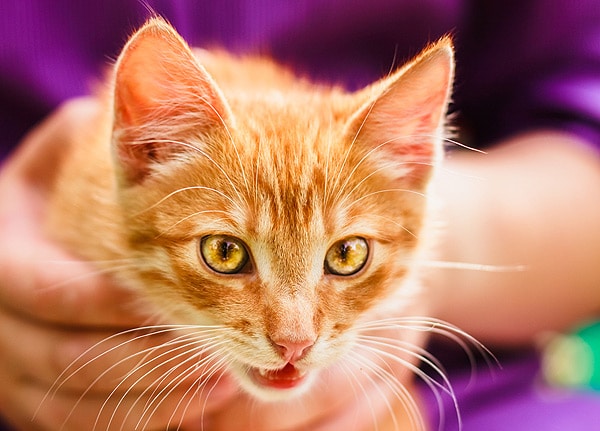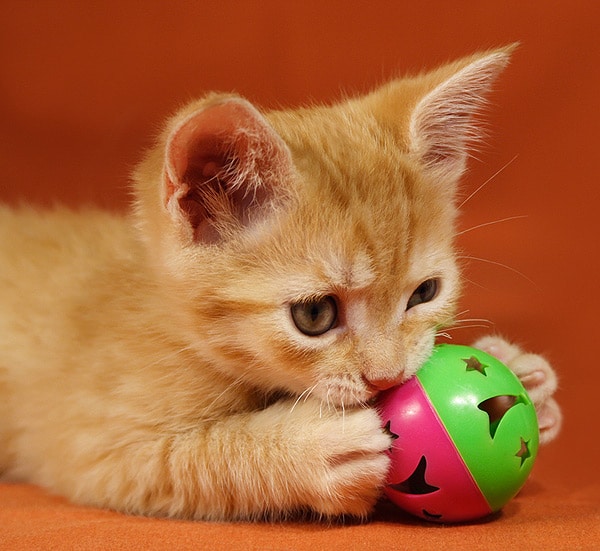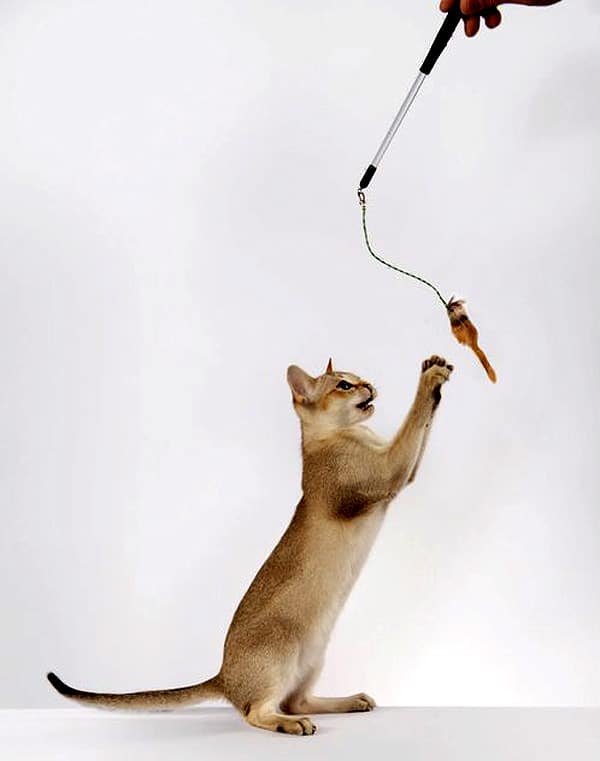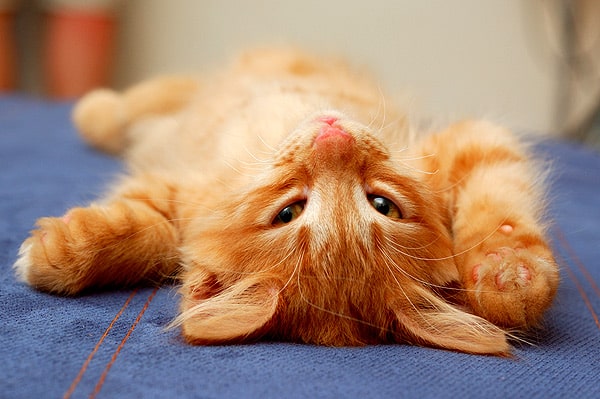It is hard to resist playing with kittens. How people play with kittens can make the difference between kittens becoming gentle cats or morphing into Ninja Attack Cats.
Meet Zack, a four-month-old orange fluff ball who shares his world with Sue, Steve, and their teenage daughter, Sam. Although cute in his fluffiness, Zack is an orange ball of terror, scratching and biting his adoring people when playing and soliciting attention. According to his humans, the only times he does not bite or scratch are when he is either eating or sleeping. Sue contacted me last week for a cat behavior consultation. She was desperate for help, and she asked whether I could come to their house and train Zack to stop being aggressive.

Watch how your play with your cat
Sue and Sam greeted me at the door while Steve played with Zach in the living room. I watched as Steve roughhoused with the kitten, rolling him on his back, teasing him, and roughing up his fur. Not surprisingly, the kitten responded by wrapping his paws around Steve’s arm, kicking, and biting. The man changed his tactics, hiding his hand under a newspaper, encouraging Zack to stalk and attack his moving fingers. Steve let out a yelp as the kitten grabbed his hand and bit, drawing blood. He immediately scruffed the kitten and held him down on the table until he cried.
Steve had read somewhere on the Internet that scruffing and holding cats and kittens down will stop aggression, because it is what cat moms do when disciplining kittens. I told him not to believe everything he reads on the Internet.
Scruffing and holding down cats can cause them to become stressed and afraid of their people. In some cases, it causes aggressions to escalate. I also reminded Steve that he is not a cat. Queens communicate to their kittens through body language and specific vocalizations, which people cannot imitate. There are more effective and stress-free ways for stopping play aggression.
The business of play
Kittens play intensely — it is what healthy, growing kittens do. Play, although fun, is serious business. Play teaches kittens survival skills, such as hunting and self-defense. In addition, kittens learn important social skills. They discover boundaries and learn to inhibit their biting. Play also helps kittens develop coordination, and it is mentally stimulating.

Kittens are little sponges when it comes to learning — they have to be in order to survive in a hostile world. One way they learn is through the consequences of their behaviors. Kittens, like all animals, repeat behaviors when the behaviors are rewarded and reinforced. Zach enjoyed interacting with his people, and he loved the attention he received from Steve when he played with him. As far as the kitten was concerned, biting and scratching was the thing to do. Steve reinforced the behavior by roughhousing and using his hands while playing. It was only natural that the behavior escalated. Zach had morphed into a Ninja Attack Cat.
How to change behaviors
Zach’s behavior can be modified, but only if everyone in the household changes the way they relate to the kitten. There is a right way and a wrong way to play.
To stop Zach’s play aggression, Steve has to quit using his hands and roughhousing. Instead, he needs to learn how to use toys when playing. Most cats and kittens enjoy chasing critters attached to the end of pole-type toys. Neko flies and Da Bird work well for the chase game. These toys should only be available to the kitty when there is someone around to supervise. When choosing toys and pole critters, avoid ones that are segmented and can be dismembered, as well as those that can be swallowed.

A very effective way of play, developed by Pam Johnson-Bennett, a certified cat behavior consultant, involves playing in a way that imitates the hunt — moving the toy away from the cat and mimicking the unpredictable movements of prey. The kitty is encouraged to catch the toy throughout the game, but after the last catch of the session, the cat is given a satisfying meal or a substantial treat. After feasting, the cat will eat, groom and then go to sleep.
Zach, a typical kitten, needs many play sessions throughout the day. In addition, Zach needs lots of stimulating toys to play with. Turbo Scratchers are popular with the feline set. These are ball and tract toys that have cardboard scratchers in the middle. Puzzle boxes are also good toys for cats. Both of these toys are perfect for hiding treats in. Paper bags without handles and cardboard boxes are also a huge hit with kittens.

Use time-outs for play aggression
Correct play is half of the equation. Zach’s human companions also need to learn the art of effectively using time-outs. Time-outs for play aggression are short and easy to do. They are usually no longer than a few seconds — longer time-outs are rarely necessary, and they’re ineffective for this type of aggression.
Whenever Zach becomes overstimulated or aggressive, his victims need to stand up and leave the area without interacting with him. That means no vocalizing, hand gestures, or eye contact. After Zach calms down, his human companions can gently pet him again. After a few time-outs, the kitten will gradually stop biting and scratching. He will learn that whenever he plays aggressively, his favorite playmates disappear.
Everyone in the household needs to participate, changing the way they interact with the kitten. With consistency, Zach will become a gentle kitten, safe to snuggle again.
Do you have a cat who bites during play? What have you done to stop it? Let us know in the comments!
Top photo: Hissing Maine Coon by Shutterstock.
More Catster articles on cat behavior issues:








